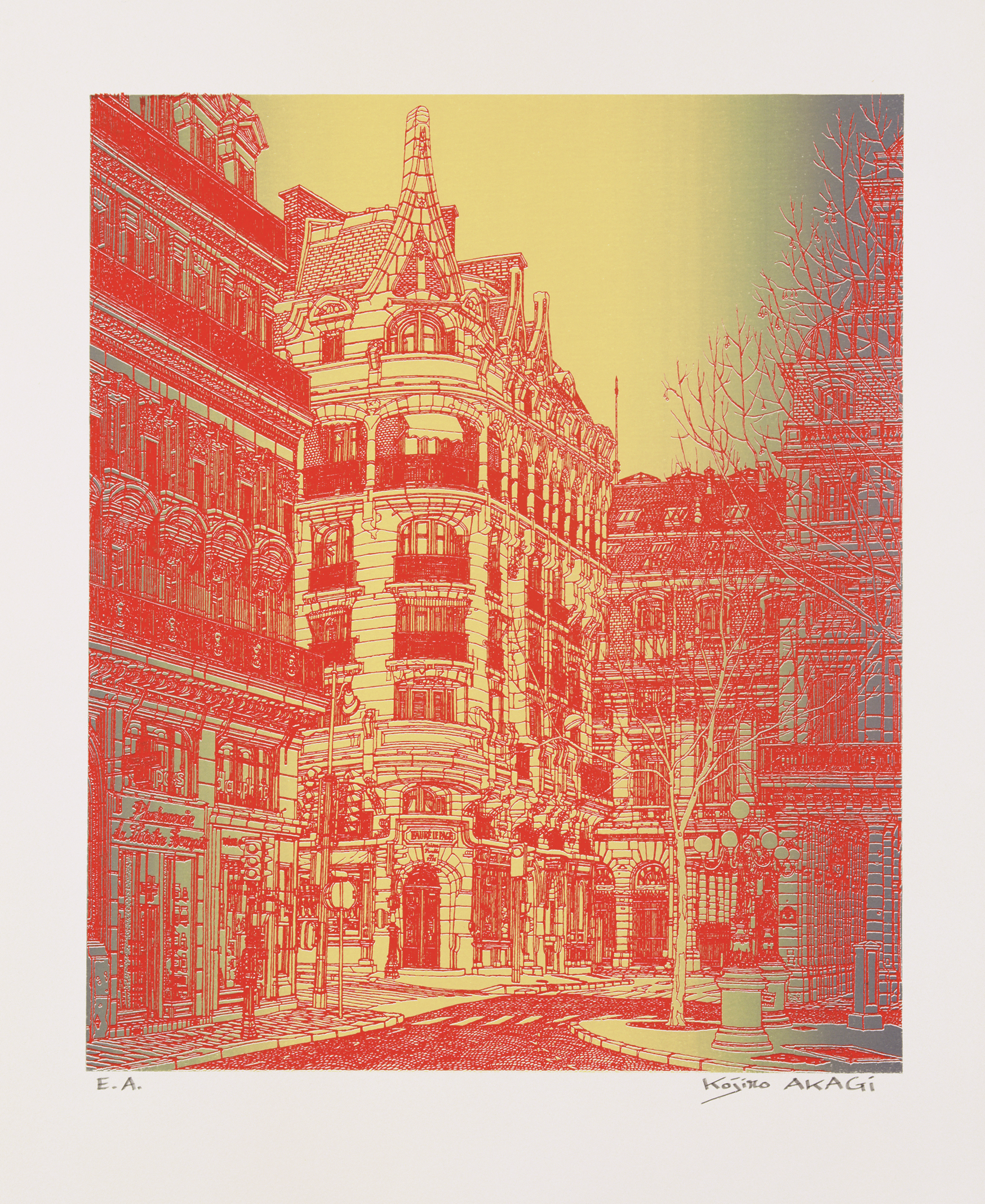Place André-Malraux / Place André-Malraux / アンドレ・マルロー広場
Dublin Core
タイトル (Title)
Place André-Malraux / Place André-Malraux / アンドレ・マルロー広場
テーマ (Subject)
Place, Sérigraphie
詳細 (Description)
Sur cette place se dresse la Comédie Française, haut lieu du théâtre français. A sa construction
en 1867, la place est connue sous le nom de «place du Théâtre-Français». C’est en 1977 qu’elle devient «place André Malraux», en hommage au premier ministre d’État chargé des Affaires culturelles, nommé par le Président de Gaulle. Il faut savoir qu’à Paris, le nom des rues ou des places peut se modifier au fil du temps. Inauguré en 1856, l’Hôtel du Louvre donnant sur cette place est toujours en activité. C’est ici que la première délégation du shogunat Tokugawa, composée de TAKEUCHI Yasunori ou FUKUZAWA Yukichi, a séjourné lors de la signature des premières relations diplomatiques franco-japonaises. Le chef de clan Okayama, IKEDA Nagaoki, représentant de la deuxième délégation, y résida également. L’endroit est situé à proximité de l’ancien Palais Royal où sont concentrés de nombreux bâtiments administratifs, la Comédie française, le Conseil d’État et le Conseil Constitutionnel, très discrets et peu connus des touristes. Le bâtiment à gauche du tableau est aujourd’hui un hôtel. À la révolution française, c’est une armurerie qui est pillée au moment de la prise de la Bastille. Avant de se transformer en hôtel, ce lieu sert de bureaux à plusieurs organisations liées au textile, comme l’Union des industries textiles de France ou la Fédération Française de l’industrie du Vêtement Masculin. Avec le temps, elles sont balayées par le flot de produits importés à bas coûts.
en 1867, la place est connue sous le nom de «place du Théâtre-Français». C’est en 1977 qu’elle devient «place André Malraux», en hommage au premier ministre d’État chargé des Affaires culturelles, nommé par le Président de Gaulle. Il faut savoir qu’à Paris, le nom des rues ou des places peut se modifier au fil du temps. Inauguré en 1856, l’Hôtel du Louvre donnant sur cette place est toujours en activité. C’est ici que la première délégation du shogunat Tokugawa, composée de TAKEUCHI Yasunori ou FUKUZAWA Yukichi, a séjourné lors de la signature des premières relations diplomatiques franco-japonaises. Le chef de clan Okayama, IKEDA Nagaoki, représentant de la deuxième délégation, y résida également. L’endroit est situé à proximité de l’ancien Palais Royal où sont concentrés de nombreux bâtiments administratifs, la Comédie française, le Conseil d’État et le Conseil Constitutionnel, très discrets et peu connus des touristes. Le bâtiment à gauche du tableau est aujourd’hui un hôtel. À la révolution française, c’est une armurerie qui est pillée au moment de la prise de la Bastille. Avant de se transformer en hôtel, ce lieu sert de bureaux à plusieurs organisations liées au textile, comme l’Union des industries textiles de France ou la Fédération Française de l’industrie du Vêtement Masculin. Avec le temps, elles sont balayées par le flot de produits importés à bas coûts.
The Comédie-Française, the home of French theatre, faces this square. When this square was opened in 1867 it was called ‘Theatre Square’. In 1977 it was renamed by adapting the name to today’s Andre Malraux Square to commemorate the name of the first Minister of Culture at the time of President De Gaulle. Street names and names of squares in Paris are changed to reflect the times.Hotel de Louvre was opened in 1856 facing the Square. Members of the first Japanese embassy to Europe, sent by Tokugawa Shougunate when diplomatic relations between Japan and France started, like Yasunori Takeuchi and Yukichi Fukuzawa, stayed at this hotel.
Nagaoki Ikeda, the governor of Okayama, was the head of the Second Japanese Embassy to Europe and he also stayed at this hotel. It has been in operation since then. The current Royal Palace is located here, surrounded not only by theatres but also the French Supreme Administrative Agency and Constitutional Council. These important institutions operate quietly, unbeknownst to tourists.The building to the far left in this work is currently a hotel with a long-established gun shop on the ground floor. It is said that people took guns from this shop during the storming of the Bastille. Before being a hotel it was occupied by different organizations such as the Federation of the French Apparel Industry. Over the years, the French apparel industry has diminished due to the rise in popularity of cheap, imported garments.
Nagaoki Ikeda, the governor of Okayama, was the head of the Second Japanese Embassy to Europe and he also stayed at this hotel. It has been in operation since then. The current Royal Palace is located here, surrounded not only by theatres but also the French Supreme Administrative Agency and Constitutional Council. These important institutions operate quietly, unbeknownst to tourists.The building to the far left in this work is currently a hotel with a long-established gun shop on the ground floor. It is said that people took guns from this shop during the storming of the Bastille. Before being a hotel it was occupied by different organizations such as the Federation of the French Apparel Industry. Over the years, the French apparel industry has diminished due to the rise in popularity of cheap, imported garments.
フランス演劇の本山、コメディ・フランセーズ座がこの広場に面している。一八六七年この広場ができてから、フランス劇場広場と呼ばれていたが、一九七七年に現在のアンドレ・マルロー広場と、ドゴール大統領の有名な文化顧問、初代の文化大臣の名前に代えられて、記念された。パリの中の、通りや広場の名前は、時の流れで、よく新設追加されたり、変更されているので、要注意なのである。 この広場に面して、一八五六年に開いたルーブルホテルは、日本とフランスの国交が始まって、初めての第一回徳川幕府遣欧使節の竹内保徳や、随行の福沢諭吉などが泊まったホテルで、岡山藩主池田長発(ながおき)の来た第二回目もここだったが、ホテルはそのまま続いている。この周り元パレ・ロワイアル宮殿があるので、劇場だけでなく、フランス最高の行政機関、フランス国務院とか、フランス憲法審議院など、地味なのに国家の最重要機関が、入り口を開いているのだが、ツーリストには全然目立たない。絵の左端の前世紀始め頃の建物も、現在はホテルに代わったが、一階の鉄砲屋はフランス革命の時に、この店から鉄砲を持ってバスチーユに押しかけたという、その老舗が続いているのだし、ホテルになる前は、いろいろな団体事務所が入っていて、フランスアパレル産業連盟とか、フランス男子既製服連盟など、各種の衣料産業の業界団体事務所が、ここに集まっていたのだった。安い外国産製品の、輸入品洪水に押されて、繊維業界も変わって行ったのだった。
制作者 (Creator)
Kojiro Akagi (1934-2021)
日付 (Date)
Juillet 1992 / July 1992
権利 (Rights)
Fonds de dotation Kojiro AKAGI
フォーマット (Format)
Sérigraphie, Atelier Del Arco, 50 tirages + 7 E.A. romain, sur papier Arches 50 x 64,5 cm.
タイプ (Type)
Sérigraphie
タグ
引用
Kojiro Akagi (1934-2021), “Place André-Malraux / Place André-Malraux / アンドレ・マルロー広場,” Kojiro Akagi - Fonds de dotation Kojiro AKAGI , accessed 2026年1月7日, https://kojiroakagi.com/gallery/items/show/45.

